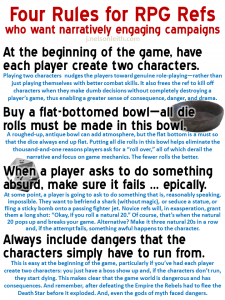
Novels, films, and stage plays are not the only story-telling media where narrative and drama are essential. Role-playing games—which were originally and ideally conceived as an open-ended alternative to win-or-lose games—work best as a sort of quasi-improvisational group theater using objective tools (dice and paper, or computer code) to maintain the integrity of the setting.
RPGs were corrupted almost immediately, however, by the same sorts of extrinsic motivations that corrupt our real lives, like wealth and power. In fact, many games we call “role-playing games” are really thinly veiled win-or-lose games, no less driven by the collection of points than a football game.
I don’t use the word “corrupted” to imply that there’s anything wrong with this sort of power-up adventure gaming. I compared it to football and I’m a football fan. Scoring points and defeating foes can be quite fun.
But, if “role-playing game” is to have any meaning, games that deserve that moniker need to be driven by playing roles, not scoring points. And playing roles has more in common with acting and writing than with sports. This is why anyone trying to run a game that is truly engaging and truly an RPG can learn a lot from the narrative and drama of novels, plays, and film.
A SIDEBAR ON GAMES
Sports fans might protest at this point that there is a narrative to sports. I would agree. But, the grand narrative of sports transcends individual games, tournaments, and championships. The narrative sense in sports comes from rising above the momentary win-or-lose aspect to the ongoing drama of players and coaches and franchises.
And, therefore, the narrative drama in sports comes from the rules of real life, not the rules of the game. This doesn’t diminish the game, it just puts it in its proper context. The win-or-lose games take place inside the real life narrative.
The power of role-playing games (and novels, and theater, and film) is to create a microcosm of “real life” in which smaller win-or-lose games can take place even while the narrative moves forward. A gaming session might end, just as a novel or play or film might end, but there is no sense that what was going on in it is “over,” unlike win-or-lose games.
Also, there’s a third style of game, open-ended like role-playing, but without any engagement in narrative progress or drama. Let’s call it the “just-for-fun” style of play.
When you’re roaming around San Andreas, stealing airplanes, jumping ice-cream trucks over waterfalls, and seeing how far into a military base you can run before getting wasted by soldiers, there’s no role-playing or winning going on, necessarily. In fact, sometimes what would conventionally be thought of as losing—like getting knocked off a bicycle by a cop car, flying off an overpass, and slamming headfirst into a storefront to the horrified gasps of pedestrians—can be a “win” during just-for-fun play.
This sort of exploratory play (which would include the Grand Theft Auto antics described above, as well as just standing atop a cliff in Red Dead Redemption to watch the sun set) can be embedded inside WOL and RPG play, just as aspects of both of those can be embedded in JFF. But, it’s helpful to think of them as three distinct styles in order to discuss how to boost the power of the role-playing style.
HOW TO DO IT
What I’m about to say is focused more on pen-and-paper, tabletop RPGs than video games, but the same principles apply. Where the cross-over value isn’t clear for computer RPGs, I’ll try to clarify.
Different tabletop RPGs use different terms for the person running the game and maintaining the integrity of the setting. Sometimes they’re called Game Masters or GMs, or the classic DM for Dungeon Master. I’m going to use the term referee, or “ref” for short, to emphasize their ideal role as wards of the rules of the  setting.
setting.
In video RPGs, of course, the computer code is the ref.
So, here’s the meat of the post: four rules for RPG refs to maintain the narrative engagement of their games.
REAL LOSSES
Infinite second chances can be useful for JFF and WOL play, but it undercuts the drama of RPGs. As we’ve learned from Game of Thrones, the real threat of character death adds punch to the story.
But, it can also sour a player on the game when their only character gets smeared.
The solution is to have each player roll up more than one character at the beginning of play, so they can experience the seriousness of the story’s stakes without losing everything. In games I’ve refereed, I have insisted on at least two characters per player, and encouraged players not to think of them in terms of primary and secondary.
Another bonus of this tactic is that it nudges the player to create distinct personalities for each character, incentivizing genuine role-playing rather than just playing themselves in another setting. Nothing scuttles the true potential of RPG play than reducing it to a lazy fantasy of “what I would do if I were in Middle Earth.”
It’s harder to implement this sort of dynamic into video RPGs, which can’t easily replicate the “making it up on the fly” style that table-top refs enjoy. Video games are designed more like “choose your own adventure” books than open-ended RPG campaigns, with each step pushing the player through a preconceived storyline.
Even so, as game design becomes more flexible and multi-character stories more workable (GTA V‘s three-character storyline is a step in the right direction) the designers should give this dynamic a serious look.
REAL-ISM (HIDE THE MECHANICS)
During the first season of TURИ : Washington’s Spies (before the show runners added the subtitle that more clearly tied it to the book it was based on) there’s a scene where Caleb Brewster is rowing a boat to a truly incredible rendition of the classic tune Spanish Ladies performed by Sarah Blasko.
The scene was universally panned, however, because the CGI used to insert the boat into the background was sloppily done. We were yanked out of an engrossing narrative by a reminder of the mechanics of film-making.
Table-top RPGs suffer from the same problem, but we don’t often notice because rolling dice and flipping through rule books are so central to game play. My advice is to reduce these distractions as much as possible.
First, choose an easy-to-remember system to reduce rule references. Second, buy a flat-bottomed bowl where all die rolls have to be made, to reduce the incidence of roll-overs and disputes over whether a roll was fair. The more the design of the bowl matches the mood of the setting, the better. Find a quirky dice bowl, and a setting-invoking set of dice.
Other neat tricks include setting-specific background music/noise and imagery, although I would advise against using miniatures, as these can lend a boardgame sense of WOL play. Risk and chess are not RPGs, so don’t play RPGs like Risk or chess.
Again, among video games the Grand Theft Auto series represents the cutting edge toward advancing this RPG dynamic. The screens of too many video RPGs are crowded with game mechanic displays that remind you that you’re playing a video game. The Mario-style collectibles in the Assassin’s Creed series are a good example of this sort of distraction. The less of it, the better.
REAL CONSEQUENCES
Refs often fall into the trap of interpreting the possibility of critical success rolls as a license for players to try anything. Do not fall into this trap.
At some point, a player is going to try to do something that is simply ridiculous. They’ll want to seduce an inanimate object, or fling a sticky bomb onto a passing fighter jet, or tame a carnivorous plant. Novice refs will give in, telling the player they have to roll a natural 20 to succeed. And that’s when Murphy’s Law gives the player a natural 20 (a 5% probability) turning the game into a farce.
Sometimes, you just have to tell the player No. Or, as an alternative, tell them they have to make three natural 20s in a row (a 1 in 8000 chance) and if they fail, something spectacularly awful happens to their character.
REAL THREATS
Making death and difficulty real are often not enough. In truly engaging stories, there are some threats that the characters realize are just too dangerous to engage. Think about the hobbits in The Fellowship of the Ring hiding under roadside roots from the Nazgûl. Or later, when Gandalf had to tell the fellowship to just run from the Balrog in Moria.
Unfortunately, players don’t often understand what their characters would in these situations, and they just send them like fearless fools into suicide attacks that sympathetic refs feel obliged to find escapes from. My advice to refs? Don’t.
In fact, setting up an encounter where the players learn that the RPG world has threats that simply cannot be overcome with a bold frontal assault can be a good opportunity to introduce character mortality to the players. This sort of loss can really ramp up the drama.
If you want to understand why this dynamic is good for the drama of your RPG, I suggest you watch pretty much any film by Quentin Tarantino. Every one of his movies has a scene where the threat of deadly violence simmers like a subtext under an otherwise innocuous conversation. It’s riveting drama, but your players will never get to enjoy this sense of imminent peril unless you make clear that they can’t just flail their way to success against any foe.
POST-SCRIPT
MAKING MONEY AT IT
This last bit of advice is for designers of video RPGs. A lot of them smother the RPG dynamic under WOL artifacts designed to boost revenues, like giving players the opportunity to buy powerful weapons and other expansion packs. Nothing wrong with making a little money!
But, RPG play can make money too. It just takes a little insight into human psychology. It helps if you understand that the distinction between WOL and RPG play mirrors the distinction between extrinsic and intrinsic motivations.
Extrinsic motivations like power and status are easy targets for video RPG profit models. A studio can pump out endless new weapons, boosts, skins, etc. for sale and players will eat them up to get advantages over other players. But, this can be a bit labor-intensive for the designers.
The breakthrough insight is that intrinsic motivations like emotional investment and relationships can drive profit models, too. If you design a game that ramps up the drama in an organic way, players will keep spending money on the game because of their relationship with the other players and with the game itself.
The difference is in the targeting expertise. If you want to hook players with intrinsic motivations rather than extrinsic motivations, you have to hire writers in addition to coders. Writers understand the four rules I’ve outlined above in ways that coders might not. It means DLC that’s more story-oriented that buff-oriented, but we already see this sort of thing in the expansions to many video RPGs.
Think The Ballad of Gay Tony. These sorts of expansion packs are cheaper to develop than full-fledged games, but they can draw profits as if they were. The strategy is out there, but it just isn’t being done as well as it could be.
Drama-driven, intrinsic motivation profit models represent a long-view investment strategy relative to the extrinsic good model of selling players on the next power-gaming boost, but it also has greater staying potential. Buying bigger and bigger guns gets boring after a while, but think about how successful drama series like Breaking Bad and Game of Thrones keep viewers coming back year after year.
There’s a world of money to be made offering players better stories rather than just better chances at killing other players.

